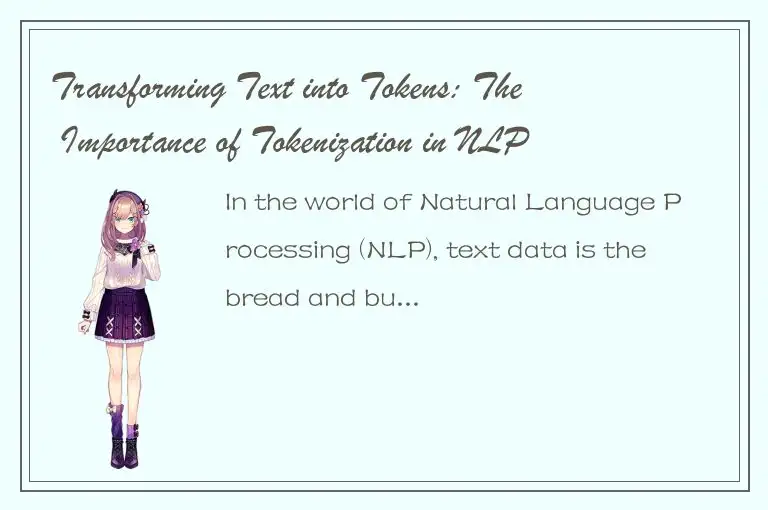In the world of Natural Language Processing (NLP), text data is the bread and butter. It's a trove of valuable information that unlocks a wealth of insights, from sentiment analysis and opinion mining to chatbot development and automated summarization. But to make sense of raw text data, NLP models need a way to break it down into smaller, more meaningful units. This is where tokenization comes in.

Tokenization is the process of breaking down a piece of text into smaller units called tokens. These tokens are often words, but they can also be phrases, sentences, or even individual characters. The goal of tokenization is to create a structure that makes it easier for machines to analyze and understand the text data. In this article, we'll explore the importance of tokenization in NLP, the different types of tokenization algorithms, and some best practices for tokenizing your text data.
Why Is Tokenization Important in NLP?
Tokenization is a critical step in the NLP pipeline because it transforms raw text into a format that machines can understand. By breaking text down into individual units, tokenization creates a structure that makes it easier for machines to process and analyze the text data. This structure allows NLP models to identify patterns, relationships, and insights that would be difficult or impossible to detect in unstructured text data.
One of the primary benefits of tokenization is that it makes it easier to compare, classify, and categorize text data. For example, imagine you're building an NLP model that identifies the sentiment of social media posts. Without tokenization, the model would need to analyze the entire post as a single block of text. This would be challenging because sentiments are often contained within specific words or phrases. By tokenizing the text into individual words, the model can more easily identify the words and phrases that are most indicative of positive or negative sentiment.
Another benefit of tokenization is that it can help to reduce the dimensionality of text data. In other words, it can make the text data more manageable by breaking it down into smaller units. This is particularly useful for NLP models that have limited computational resources or are working with large volumes of text data.
Types of Tokenization Algorithms
There are many different types of tokenization algorithms, each with its own strengths and weaknesses. Some of the most common types of tokenization algorithms include:
1. Word Tokenization: This is the most common type of tokenization algorithm, which breaks text down into individual words. In some cases, the algorithm may also group together certain types of words, such as numbers, dates, or proper nouns.
2. Sentence Tokenization: This algorithm breaks the text down into individual sentences. This can be useful for tasks like summarization or text classification, where understanding the context of a sentence is critical.
3. Character Tokenization: This algorithm breaks the text down into individual characters. This can be useful for tasks like handwriting recognition or text-to-speech conversion.
4. Subword Tokenization: This algorithm breaks the text down into smaller units that are a combination of individual characters and words. This can be useful for languages with complex morphology, where many words are composed of multiple meaningful parts.
Best Practices for Tokenizing Text Data
While there's no single "right" way to tokenize text data, there are some best practices that can help ensure that the resulting tokens are accurate, consistent, and useful for NLP tasks:
1. Use a well-established tokenization algorithm: There are many different tokenization algorithms to choose from, but you'll want to choose one that's been well-tested and validated for your use case.
2. Consider your preprocessing steps carefully: Before tokenizing your text data, you may want to perform some preprocessing steps like removing stop words or stemming. These steps can help to improve the accuracy of your tokens.
3. Be mindful of your data's context: Depending on your use case, the context of your text data may be critical. For example, if you're analyzing medical records, you may need to use a different tokenization algorithm than if you're analyzing social media posts.
4. Evaluate and refine your tokens: Once you've tokenized your text data, it's important to evaluate the resulting tokens and make adjustments as needed. This can help to ensure that your NLP models are accurate and effective.
Conclusion
Tokenization is a critical step in any NLP pipeline. By breaking down text data into smaller units, tokenization creates a structure that makes it easier for machines to process and analyze the data. Whether you're building chatbots, analyzing customer feedback, or developing language models, tokenization is an essential tool for unlocking insights from raw text data. By using well-established tokenization algorithms and following best practices, you can ensure that your tokens are accurate, consistent, and useful for your NLP tasks.




 QQ客服专员
QQ客服专员 电话客服专员
电话客服专员